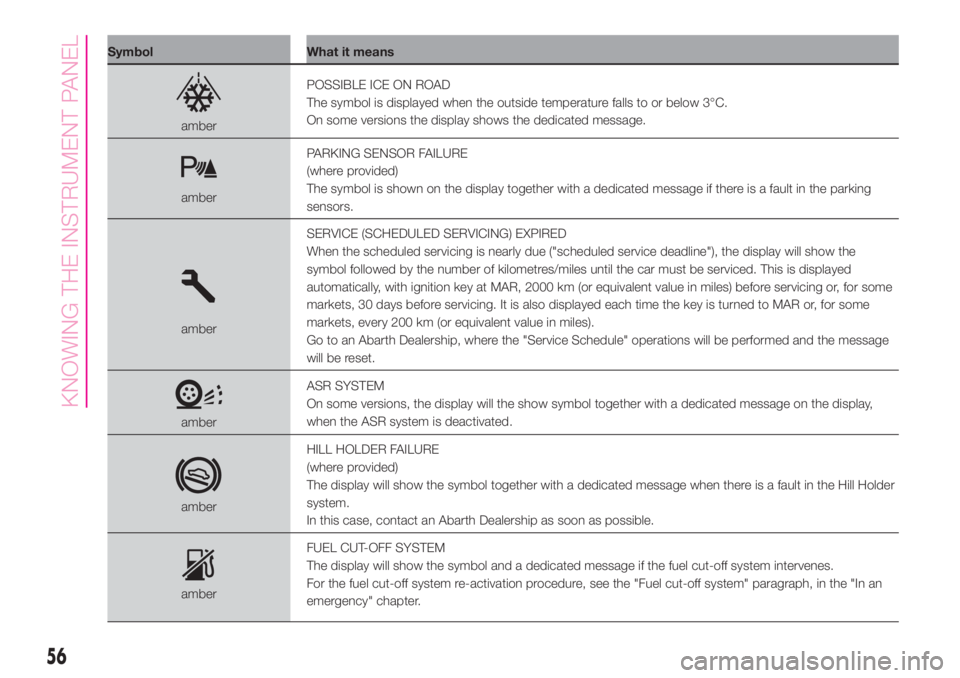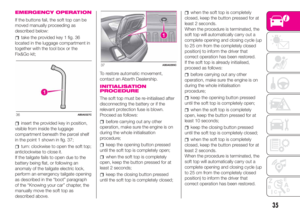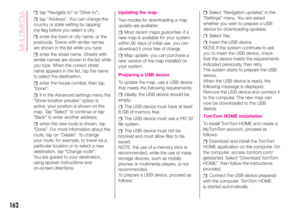Page 57 of 196

Symbol What it means
redENGINE COOLANT TEMPERATURE TOO HIGH
On some versions, the symbol appears on the display when the engine is overheated together with a
dedicated message on the display.
In normal driving conditions: stop the car, switch off the engine and check that the fluid level in the
reservoir is not below the MIN mark. In this case, wait for the engine to cool down, then slowly and
carefully open the cap, top up with coolant and check that the level is between the MIN and MAX marks on
the reservoir itself. Also check visually for any fluid leaks. Contact an Abarth Dealership if the warning light
switches on when the engine is started again;
If the car is used under demanding conditions(e.g. when fully loaded): slow down and, if the
warning light stays on, stop the car. Stop for two or three minutes with the engine running and slightly
accelerated to facilitate better coolant circulation, then turn the engine off. Check that the coolant level is
correct as described above.
IMPORTANT Over demanding routes, it is advisable to keep the engine running and slightly accelerated for
a few minutes before turning it off
redROBOTISED SEQUENTIAL GEARBOX FAILURE
When the ignition key is turned to MAR, the icon appears but should disappear after a few seconds.
The icon flashes, along with a dedicated message on the display and an acoustic warning, to indicate
transmission failure.15)
redAirbag warning light failure(where present)
The icon lights up when a fault is detected in the warning light
.
redSPEED LIMIT EXCEEDED
The symbol is shown on the display, together with a dedicated message and an acoustic signal, when the
vehicle exceeds the speed limit set in the Setup Menu (e.g. 120 km/h). For some markets, the symbol is
red.
55
Page 58 of 196

Symbol What it means
amberPOSSIBLE ICE ON ROAD
The symbol is displayed when the outside temperature falls to or below 3°C.
On some versions the display shows the dedicated message.
amberPARKING SENSOR FAILURE
(where provided)
The symbol is shown on the display together with a dedicated message if there is a fault in the parking
sensors.
amberSERVICE (SCHEDULED SERVICING) EXPIRED
When the scheduled servicing is nearly due ("scheduled service deadline"), the display will show the
symbol followed by the number of kilometres/miles until the car must be serviced. This is displayed
automatically, with ignition key at MAR, 2000 km (or equivalent value in miles) before servicing or, for some
markets, 30 days before servicing. It is also displayed each time the key is turned to MAR or, for some
markets, every 200 km (or equivalent value in miles).
Go to an Abarth Dealership, where the "Service Schedule" operations will be performed and the message
will be reset.
amberASR SYSTEM
On some versions, the display will the show symbol together with a dedicated message on the display,
when the ASR system is deactivated.
amberHILL HOLDER FAILURE
(where provided)
The display will show the symbol together with a dedicated message when there is a fault in the Hill Holder
system.
In this case, contact an Abarth Dealership as soon as possible.
amberFUEL CUT-OFF SYSTEM
The display will show the symbol and a dedicated message if the fuel cut-off system intervenes.
For the fuel cut-off system re-activation procedure, see the "Fuel cut-off system" paragraph, in the "In an
emergency" chapter.
56
KNOWING THE INSTRUMENT PANEL
Page 59 of 196

Symbol What it means
amberFUEL CUT-OFF SYSTEM FAILURE
The display will show the symbol and a dedicated message if the fuel cut-off system is faulty.
amberEXTERIOR LIGHTS FAILURE
(where provided)
The symbol is shown on the display together with a dedicated message when there is a fault in one of the
following lights:
daytime running lights (DRL)
side lights
direction indicators
rear fog light
number plate lights.
The anomaly relating to these lights could be: one or more blown bulbs, a blown protection fuse or a break
in the relevant electric connection.
amberBRAKE LIGHT FAILURE
(where provided)
The display will show the symbol together with a dedicated message if there is a fault in the brake lights.
The fault may be caused by a blown bulb, a blown protection fuse or a break in the relevant electrical
connection.
amberFIAT CODE SYSTEM FAILURE
With the key in the MAR position, on some versions the warning light, or the symbol on the display, turns
on continuously, along with a dedicated message on the display, to signal a possible Fiat CODE system
failure.
If the symbol appears on the display with engine running, it means that the car is not protected by the
engine immobiliser device.
In this case, contact an Abarth Dealership as soon as possible.
57
Page 60 of 196

Symbol What it means
amberFUEL RESERVE - LIMITED RANGE
When the key is turned to MAR, the icon appears but should disappear after a few seconds.
The symbol switches on in the display when about 5 litres of fuel are left in the tank. The triangle to the side
of the symbol indicates the side of the car with the fuel filler.
amberENGINE OIL PRESSURE SENSOR FAILURE INDICATOR
The icon appears when a fault is detected in the engine oil pressure sensor.
Contact an Abarth Dealership as soon as possible to have the fault fixed.
amberOIL CHANGE
The icon indicates that it is necessary to change the engine oil. Contact an Abarth Dealership.
amberPRESS THE CLUTCH PEDAL TO START
This symbol turns on to indicate that the clutch pedal must be pressed to enable starting.
amberFUEL LEVEL SENSOR FAILURE
The symbol switches on in the event of fuel level sensor failure. Contact an Abarth Dealership.
amberRAIN SENSOR FAILURE
The symbol switches on in the case of failure of the rain sensor. Contact an Abarth Dealership as soon as
possible
amberDUSK SENSOR FAILURE
The symbol switches on along with a message on the display in the event of dusk sensor failure. Contact
an Abarth Dealership as soon as possible.
58
KNOWING THE INSTRUMENT PANEL
Page 61 of 196

Symbol What it means
whiteHEADLIGHT ALIGNMENT CORRECTOR
The icon, together with a number, indicates the depth of the dipped beam.
WARNING
34)If, when turning the key to MAR, thewarning light does not switch on or if it stays on when travelling, there could be a fault in the
restraint systems; in this event airbags or pretensioners may not be deployed in the event of impact or, in a lower number of cases, they may
deploy accidentally. Before driving off, contact an Abarth Dealership to have the system checked immediately.
35)A failure of the
warning light is indicated by thesymbol on the display. In this case, thewarning light may not indicate a
possible problem with the airbag restraint system. Before driving off, contact an Abarth Dealership to have the system checked immediately.
36)If the
warning light turns on when travelling (on certain versions together with the message on the display) stop the vehicle
immediately and contact an Abarth Dealership.
37)If the
warning light switches on when driving (on certain versions together with a dedicated message on the display) stop the engine
immediately and contact an Abarth Dealership.
38)If the warning light flashes or the symbol is constantly on, depending on the versions, there is a fault in the system. If this is the case, go
to an Abarth Dealership to have the system checked.
39)If, when the ignition key is turned to MAR, the
warning light does not switch on, switches on constantly or flashes while driving (on
certain versions together with the message on the display), contact an Abarth Dealership as soon as possible. The operation of the
warning light may be checked by the traffic police using specific devices. Comply with the laws and regulations of the country where you
are driving.
WARNING
15)If there is a fault in the gearbox, contact an Abarth Dealership as soon as possible to check the system.
59
Page 62 of 196
SAFETY
The chapter that you are about to read
is very important: it describes the
safety systems with which the vehicle is
equipped and provides instructions on
how to use them correctly.ACTIVE SAFETY SYSTEMS ............ 61
ITPMS (INDIRECT TYRE
PRESSURE MONITORING
SYSTEM) ........................................ 64
OCCUPANT PROTECTION
SYSTEMS ....................................... 66
SEAT BELTS ................................... 67
SBR SYSTEM (SEAT BELT
REMINDER) .................................... 68
PRE-TENSIONERS ......................... 68
CHILD PROTECTION SYSTEMS ..... 70
SUPPLEMENTARY RESTRAINT
SYSTEM (SRS) – AIRBAG ............... 77
60
SAFETY
Page 63 of 196

ACTIVE SAFETY
SYSTEMS
The car has the following active safety
systems:
ABS (Anti-lock Braking System);
EBD (Electronic Brake force
Distribution);
DTC (Drag Torque Control);
ESC (Electronic Stability Control);
HH (Hill Holder);
ASR (Antislip Regulation);
PBA (Panic Brake Assist);
TTC (Torque Transfer Control)
For the operation of the systems, see
the following description.
ABS (Anti-lock Braking
System)
This system, which is an integral part of
the braking system, prevents one or
more wheels from locking and slipping
on all road surface conditions,
irrespective of the intensity of the
braking action, ensuring that the car
can be controlled even during
emergency braking thus optimising
stopping distances.
The system intervenes during braking
when the wheels are about to lock,
typically in emergency braking or
low-grip conditions, when locking may
be more frequent.The system also improves control and
stability of the car when braking on a
surface where the grip of the left and
right wheels varies, or on corners.
The Electronic Braking Force
Distribution (EBD) system completes
the system allowing the brake force to
be distributed between the front and
rear wheels.
System intervention
A slight pulsing of the brake pedal and
noise indicates the intervention of the
ABS: this is completely normal when
the system intervenes.
40) 41) 42) 43) 44) 45) 46) 47) 48)
DTC (Drag Torque
Control) SYSTEM
The system prevents the drive wheels
from possibly locking, which could
happen, for example, if the accelerator
pedal is released suddenly or in the
case of a sudden downshifting in
conditions of poor grip. In these
conditions, the engine braking effect
could cause the drive wheels to slip,
resulting in a loss of car stability. In
these situations, the DTC system
intervenes, restoring torque to the
engine in order to conserve vehicle
stability and increase vehicle safety.
ESC (Electronic Stability
Control) SYSTEM
The ESC system improves the
directional control and stability of the
car in various driving conditions. The
ESC system corrects the car’s
understeer and oversteer, distributing
the brake force on the wheels
appropriately. The torque supplied by
the engine can also be reduced in order
to maintain control of the car. The
ESC system uses sensors installed on
the vehicle to determine the trajectory
that the driver intends to follow and
compares it with the vehicle’s effective
trajectory. When the real trajectory
deviates from the desired trajectory, the
ESC system intervenes to counter the
understeer or oversteer of the car.
Oversteer: occurs when the car is
turning more than it should according
to the angle of the steering wheel.
Understeer: occurs when the car is
turning less than it should according to
the angle of the steering wheel.
System intervention
The intervention of the system is
indicated by the flashing of the
warning light on the instrument
panel, to inform the driver that the car is
in critical stability and grip conditions.
49) 50) 51) 52) 53) 54)
61
Page 64 of 196

HH (Hill Holder) SYSTEM
This is an integral part of the ESC
system and facilitates starting on
slopes, activating automatically in the
following cases:
uphill: car stationary on a road with a
gradient higher than 5%, engine
running, brake pressed and gearbox in
neutral or gear (other than reverse)
engaged;
downhill: car stationary on a road
with a gradient higher than 5%, engine
running, brake pressed and reverse
gear engaged.
When setting off, the ESC system
control unit maintains the braking
pressure on the wheels until the engine
torque required for starting is reached,
or in any case for a maximum of 2
seconds, allowing you to move your
right foot easily from the brake pedal to
the accelerator.
When the 2 seconds have elapsed,
without starting, the system is
automatically deactivated, gradually
releasing the braking pressure.
During this release stage, the typical
mechanical brake release noise can be
heard, indicating that the car is about
to move.
55) 56)
ASR (AntiSlip
Regulation) SYSTEM
This is an integral part of the ESC
system and automatically operates in
the event of one or both drive wheels
slipping, loss of grip on wet roads
(aquaplaning) and acceleration
on slippery, snowy or icy roads, etc.
Depending on the slipping conditions,
two different control systems are
activated:
if the slipping involves both drive
wheels, the ASR system intervenes,
reducing the power transmitted by the
engine;
if the slipping only involves one of
the drive wheels, it also intervenes
automatically, braking the wheel that is
slipping.
System intervention
This is indicated by theicon
appearing on the instrument panel, to
inform the driver that the car is in critical
stability and grip conditions.
Manual engagement/
disengagement
The ASR comes on automatically
whenever the engine is started. Whilst
driving, the ASR can be switched off
and subsequently switched on again by
pressing button 1fig. 51 (TTC). When
the system is not active, the LED on the
same button turns on and, on some
versions, a message appears on the
display. If the ASR is disengaged during
driving, this is automatically reactivated
at the following car starting.
When travelling on snowy roads with
snow chains, it may be helpful to turn
the ASR off: in fact, in these conditions,
the driving wheels skidding when
moving off gives you better traction.
57) 58) 59) 60) 61) 62)
PBA (Panic Brake
Assist) SYSTEM
The PBA system is designed to
improve the vehicle’s braking capacity
during emergency braking.
The system detects an emergency
braking by monitoring the speed and
strength with which the brake pedal
is pressed, thereby applying the optimal
brake pressure. This can reduce the
braking distance: the PBA system
therefore completes the ABS.
62
SAFETY
 1
1 2
2 3
3 4
4 5
5 6
6 7
7 8
8 9
9 10
10 11
11 12
12 13
13 14
14 15
15 16
16 17
17 18
18 19
19 20
20 21
21 22
22 23
23 24
24 25
25 26
26 27
27 28
28 29
29 30
30 31
31 32
32 33
33 34
34 35
35 36
36 37
37 38
38 39
39 40
40 41
41 42
42 43
43 44
44 45
45 46
46 47
47 48
48 49
49 50
50 51
51 52
52 53
53 54
54 55
55 56
56 57
57 58
58 59
59 60
60 61
61 62
62 63
63 64
64 65
65 66
66 67
67 68
68 69
69 70
70 71
71 72
72 73
73 74
74 75
75 76
76 77
77 78
78 79
79 80
80 81
81 82
82 83
83 84
84 85
85 86
86 87
87 88
88 89
89 90
90 91
91 92
92 93
93 94
94 95
95 96
96 97
97 98
98 99
99 100
100 101
101 102
102 103
103 104
104 105
105 106
106 107
107 108
108 109
109 110
110 111
111 112
112 113
113 114
114 115
115 116
116 117
117 118
118 119
119 120
120 121
121 122
122 123
123 124
124 125
125 126
126 127
127 128
128 129
129 130
130 131
131 132
132 133
133 134
134 135
135 136
136 137
137 138
138 139
139 140
140 141
141 142
142 143
143 144
144 145
145 146
146 147
147 148
148 149
149 150
150 151
151 152
152 153
153 154
154 155
155 156
156 157
157 158
158 159
159 160
160 161
161 162
162 163
163 164
164 165
165 166
166 167
167 168
168 169
169 170
170 171
171 172
172 173
173 174
174 175
175 176
176 177
177 178
178 179
179 180
180 181
181 182
182 183
183 184
184 185
185 186
186 187
187 188
188 189
189 190
190 191
191 192
192 193
193 194
194 195
195






